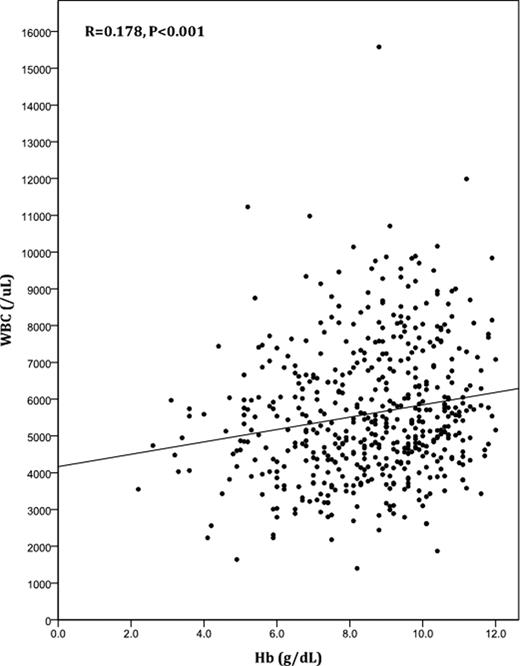Abstract
Abstract 5279
There is a lack of clinical research regarding the effect of iron deficiency anemia on white blood cells (WBC).This study presents the incidence of leukopenia in patients with iron deficiency anemia and the relationship between the white blood cell count and the level of hemoglobin(Hb).
Medical records of patients over 12 years of age with iron deficiency anemia were reviewed. Patients with concomitant disease that may alter the WBC count such as hematologic malignancy, solid tumor, history of gastrectomy, vitamin B12 or folate deficiencies and active inflammation were excluded.
From January 2006 to December 2010, a total of 516 eligible patients were included. Median age was 47 years with female predominance (80.6%). Leukopenia was found in 91 patients (17.6%). The incidence of leukopenia was significantly higher in patients with hemoglobin level of less than 8 g/dL than those with higher level of hemoglobin (44/183, 24.0% vs. 47/333, 14.1%, P=0.005, Table 1).
The levels of WBC count were found to decrease in accordance with the decrease in hemoglobin level (Pearson's coefficient: 0.178, P<0.001, Figure 1). The decrease in WBC count was seen more often in younger patients. (R=0.104, P=0.018) Also, lymphocytes were found to decrease in both total number(R=0.282, P<0.001) and percentage (R=0.122, P=0.006) within total WBCs in proportion to the decrease in Hb level.
This study shows the high incidence of leukopenia in patients with iron deficiency anemia. The severity of leukopenia correlates with the decrease of hemoglobin in dose-dependent manner. Among the WBC subsets, lymphocyte count was significantly affected.
No relevant conflicts of interest to declare.
Author notes
Asterisk with author names denotes non-ASH members.



This feature is available to Subscribers Only
Sign In or Create an Account Close Modal